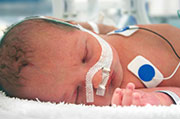
THURSDAY, Aug. 8 (HealthDay News) — Survival odds for black American infants are considerably worse than for white babies, a new U.S. study finds.
Despite a steady decline in overall infant death rates, black infants are nearly twice as likely to die before their first birthday compared to white babies, and premature black infants are three times more likely to die during their first year than premature white babies, according to figures released Thursday by the U.S. Centers for Disease Control and Prevention.
The report also notes that the South accounts for the majority of states with the highest rates of infant death.
The findings of racial and regional disparities show that challenges remain, according to the study, published in the Aug. 8 issue of the CDC’s Morbidity and Mortality Weekly Report.
Also, the United States lags behind other developed nations in terms of infant deaths. “Since 1950, medical technology has helped to reduce infant mortality, but the United States still has a relatively poor global standing,” the report states. “In 2010, the United States ranked 32nd among the 34 nations of the Organization for Economic Cooperation and Development in infant mortality.”
The overall U.S. infant death rate — defined as death within the first year of life — has declined over the past 50 years, and in 2011 was 6.05 per 1,000 live births, the report notes.
Infant deaths are mostly the result of pre-term birth, birth defects, mothers’ poor health, labor and delivery complications, lack of appropriate care at the time of delivery, sudden unexpected infant death, and infection, the researchers said.
They noted that recent national and regional partnerships may help improve the health of mothers before, during and after pregnancy, which could help prevent infant deaths.
Specific steps that can boost a baby’s chance of survival, the authors say, include: improving the health of women before they get pregnant; reducing smoking during pregnancy; stopping elective preterm deliveries; providing infants with safe sleeping environments; and ensuring that high-risk infants are born in facilities that provide the best care.
More information
The U.S. National Institute of Child Health and Human Development has more about infant care and health.
Copyright © 2025 HealthDay. All rights reserved.

